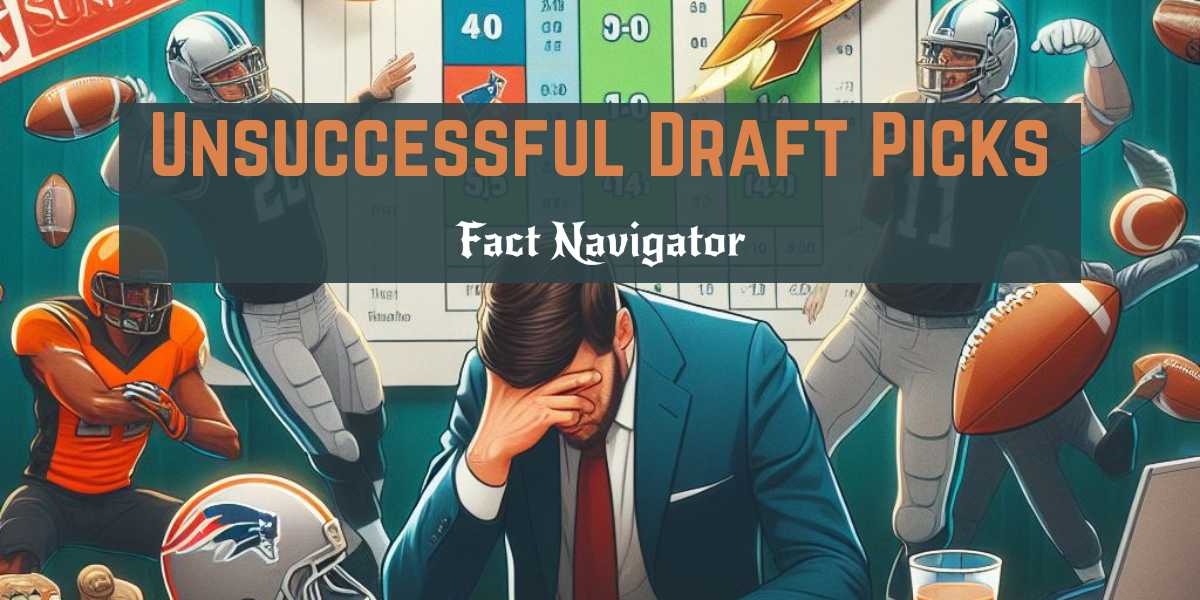Unsuccessful Draft Picks: Why They Fail & How to Avoid Them

Every draft is a gamble, a roll of the dice where teams stake their future on the potential of young athletes. The term “unsuccessful draft pick,” or more bluntly, “draft bust,” refers to those players who fail to deliver on the promise of their draft position. They’re the lottery tickets that didn’t hit the jackpot, leaving teams and fans wondering what went wrong.
Analyzing these unsuccessful draft picks is more than just morbid curiosity. It’s a crucial process for several reasons:
- Draft Forensics: Dissecting the failures of past busts is like a sports autopsy. It helps teams identify recurring patterns – whether it’s overvaluing physical tools over intangibles, ignoring character red flags, or falling prey to media hype.
- Smarter Drafting: The lessons learned from draft busts directly inform future decisions. Teams might become more risk-averse, favor players with high floors over high ceilings, or invest more heavily in pre-draft psychological evaluations. Understanding past failures is key to avoiding repeating them.
- Appreciating the Complexity: Analyzing unsuccessful draft picks gives fans a deeper understanding of the challenges faced by scouts and general managers. It highlights the unpredictable nature of player development and the fact that even the most meticulously researched pick can go awry.
It’s not just about the player who failed – it’s about the systems, biases, and sometimes sheer bad luck that can turn a highly-anticipated draft choice into an “unsuccessful draft pick”.
1. Factors Contributing to Unsuccessful Draft Pick
The transformation from promising prospect to “unsuccessful draft pick” is rarely due to one single factor. It’s a complex mix of circumstances, misjudgments, and sometimes, just plain bad luck. Let’s dissect the major contributors:
Overestimation of Talent
- College vs. Pros: Dominating at the collegiate level doesn’t guarantee success against the world’s best athletes. The jump in skill, speed, and physicality of professional leagues can be overwhelming, exposing weaknesses that went unnoticed before.
- Hype Machine: The media hype surrounding certain prospects can inflate their perceived value. Scouts and teams need to separate true potential from the buzz generated by highlight reels and flashy stats that might not translate to pro-level performance.
Injury Proneness
- Lingering Concerns: A history of injuries in college raises questions about a player’s durability. Teams may gamble on an injury-prone player with immense talent, but the risk of them becoming an “unsuccessful draft pick” due to their body breaking down is high.
- The Rigors of the Pros: Pro sports are a brutal grind. The longer season, increased physicality, and relentless travel take a toll. Some bodies simply aren’t built for it, turning talented-but-fragile players into constant fixtures on the injury report.
Character Concerns
- The Locker Room Factor: Talent alone doesn’t win championships. Off-field issues, whether it’s a lack of work ethic, poor attitude, or legal troubles, can disrupt team chemistry and derail a player’s focus.
- Maturity Matters: Drafting a young athlete is an investment in their future. Immaturity or a questionable attitude raises red flags that might indicate that the player is not ready for the responsibilities and pressures of professional sports.
Scheme Mismatch
- Wrong Fit: Systems and play styles vary drastically between teams. A player who thrived in a particular college scheme might flounder in a pro system that doesn’t accentuate their strengths.
- Adaptability Issues: Some players are rigid, unable to adjust their game or learn new roles as needed. This lack of adaptability can turn them into square pegs trying to fit into round holes, leading to stunted development.
Bad Luck
- Untimely Injuries: Sometimes, even with meticulous planning and flawless execution, cruel injuries can completely derail a career. A catastrophic injury, just as a player is hitting their stride, is an element of risk beyond anyone’s control.
- Unforeseen circumstances: Life events such as family issues, off-field problems, or external factors can have a ripple effect on a player’s trajectory.
Important Note: It’s vital to assess these factors holistically, not in isolation. It’s the combination of these risks that truly dictates whether a draft pick has the potential to bust.
2. Infamous Draft Busts in Sports History
Every sport has its cautionary tales, those high draft picks who flamed out spectacularly, becoming synonymous with the term “unsuccessful draft pick.” Let’s revisit some of the most notorious busts:
NFL
- Ryan Leaf (Quarterback, #2 overall pick, 1998): Leaf’s tumultuous career was plagued by immaturity, clashes with the media, and poor on-field performance. He’s considered a classic example of a physically gifted player whose character flaws derailed his potential.
- JaMarcus Russell (Quarterback, #1 overall pick, 2007): Russell possessed immense arm talent, but questionable work ethic and weight issues limited his development. He is often cited as a cautionary tale of teams overlooking red flags for potential.
NBA
- Kwame Brown (Center, #1 overall pick, 2001): Selected by Michael Jordan himself, Brown lacked the skill development and basketball IQ required for his draft position. This became a stark lesson in the importance of assessing a player’s intangibles, rather than just raw athleticism.
- Darko Miličić (Center, #2 overall pick, 2003): A highly touted European prospect, Miličić was scooped up in a draft full of future superstars. However, he never adapted to the NBA’s style of play and struggled to find a consistent role, highlighting the risk of drafting based on international potential.
MLB
- Brien Taylor (Pitcher, #1 overall pick, 1991): A highly-touted prospect, Taylor’s career was derailed by a shoulder injury sustained in a bar fight before he ever reached the majors. This bust underscores the unpredictable nature of injuries and the importance of off-field character assessment.
- Matt Bush (Shortstop/Pitcher, #1 overall pick, 2004): Bush’s career was plagued by legal issues and substance abuse. Despite eventually finding some success as an MLB pitcher, he’s a stark reminder that talent alone isn’t enough for sustained success.
Key Takeaways:
- These busts highlight the various factors we discussed earlier – overemphasizing physical tools, ignoring character concerns, failing to project a player into an NBA system, and the sheer bad luck of injuries.
- Analyzing these failures provides teams and fans alike with valuable lessons, ultimately improving the scouting and drafting process over time.
3. The Cost of a Failed Draft Pick
When a highly-touted draft pick turns into an “unsuccessful draft pick”, the consequences extend far beyond a player’s individual disappointment. The ripple effects are felt by the entire team, both financially and in terms of lost opportunities.
Financial Impact
- Wasted Salary Cap Space: High draft picks command significant salaries, often with hefty signing bonuses. When a player busts, that money becomes dead weight on the team’s salary cap, limiting their ability to sign other players or make necessary upgrades elsewhere on the roster.
- Sunk Costs: The investment in a draft pick goes beyond just salary. Teams spend enormous resources scouting, evaluating, and drafting players. A failed pick means those resources were essentially wasted, with no return on investment.
Opportunity Cost
- The “What If” Factor: Every draft pick represents a choice. Teams pass on other potentially impactful players in favor of the one they select. When a player busts, it’s a glaring reminder that a different pick might have set the team on a more successful trajectory.
- Rebuilding Roadblocks: Teams in rebuilding mode rely heavily on the draft to acquire young talent. A failed high pick can significantly delay their progress, forcing them to spend more years acquiring the foundational pieces they need.
- Hampering Contenders: For teams with aspirations of a championship, a draft bust can be a crippling blow. It can sabotage their carefully constructed roster, leaving a hole that might be impossible to fill via trade or free agency.
The Hidden Cost: Fan Frustration and Damaged Reputation
Beyond the tangible costs, there are intangible consequences:
- Fan Disillusionment: Fans invest emotionally in draft picks. A high-profile bust can lead to cynicism and a sense of lost hope, eroding the team’s connection to its fanbase.
- Organizational Reputation: A string of unsuccessful draft picks can damage a team’s reputation within the league. This can affect their ability to attract free agents and might even cast a shadow on how potential draft prospects view them.
Important Note: The severity of these costs varies depending on the draft position, the sport’s salary structure, and the team’s individual situation. However, even in the best-case scenario, an unsuccessful draft pick represents a missed opportunity.
4. How Teams Can Minimize the Risk of Draft Busts
While the draft will always hold an element of uncertainty, teams can significantly reduce the chance of selecting an “unsuccessful draft pick” with proactive strategies. Here’s how:
Thorough Scouting and Evaluation
While physical stats and combined results matter, teams must dig deeper. Interviews, psychological assessments, and background checks help to paint a complete picture of a player’s character, work ethic, and how well they might fit the team’s culture.
Teams need to be honest about potential pitfalls. This means identifying a history of injuries, off-field concerns, or any patterns that might raise questions about a player’s long-term reliability and commitment.
Smart Drafting Strategies
- Risk vs. Reward: Every draft pick is a calculated risk. Teams must weigh the potential upside of a high-ceiling, but unpolished player against the safer bet of a less flashy, but more reliable contributor.
- Trading Savvy: Sometimes, the smartest move is not to make a pick. Teams should be open to trading draft picks for proven players, or trading down to accumulate more picks, thereby spreading their risk and increasing chances of landing at least one solid contributor.
Player Development
- Investing in the Future: The journey doesn’t end on draft day. Teams need top-notch coaching that focuses not only on skill development, but also on the mental aspects of the professional game. They must provide mentorship and a support system that sets young players up for success.
- Culture Matters: Creating a positive, team-oriented environment can be vital. A strong locker room and supportive coaching staff can help players make the transition to the pros, maximizing their potential and minimizing the distractions that can derail them.
Important Note: There’s No Perfect Formula
Even the most diligent teams will occasionally draft players that fizzle out. But, by implementing smart scouting, strategic drafting, and a focus on development, teams can significantly stack the odds in their favor.
Possible Enhancements
- Quotes from Scouts/GMs: Adding a quote from a respected figure in sports scouting would lend credibility and provide an insider’s perspective.
- The Role of Analytics: Briefly discuss how advanced analytics and data-driven scouting models can supplement traditional methods for an even more comprehensive evaluation process.
Conclusion
The path from promising prospect to “unsuccessful draft pick” is paved with a mix of misjudgments, misfortune, and missed opportunities. Key factors that often contribute to a draft pick failing include:
- Overestimating raw talent without assessing intangibles
- Injury history and a player’s inability to withstand the physical demands of pro sports
- Off-field issues or work ethic concerns hindering a player’s potential
- A mismatch between a player’s skills and a team’s systems or needs
- The cruel reality of bad luck, such as career-altering injuries
Understanding why draft picks fail is vital for both fans and teams:
- Informed Fandom: Fans become better consumers of the draft spectacle, developing a more nuanced understanding of the risks and complexities involved in player evaluation.
- Smarter Organizations: Teams can continuously improve their processes. Analyzing past failures helps them avoid repeating mistakes, implement more in-depth vetting systems, and invest in player development resources.
The Future of Scouting: A Look Ahead
The scouting landscape is constantly evolving. Here’s where things might be heading:
- Enhanced Analytics: Expect the rise of even more sophisticated data-driven models. These models could help analyze minute details of player performance, project potential with greater accuracy, and even identify personality traits from social media footprints.
- Wearable Tech: Sensors that track on-field movements and biometric data provide an unprecedented level of insight into an athlete’s physical capabilities and potential injury risks.
- The Human Element Remains: While tech will advance, the “gut feeling” and ability to read a player’s character in person will likely remain a key component of the scouting process.
No system is foolproof. The draft will always carry an element of risk and the potential for an “unsuccessful draft pick”. However, the relentless pursuit of better evaluation methods is shaping a future where both teams and fans can make more astute decisions on draft day.


![[Noblocc] Kicked for Being AFK? Learn Secrets to Stay Active](https://factnavigator.com/wp-content/uploads/2023/12/12-noblocc-kicked-for-being-afk-768x384.jpg)



